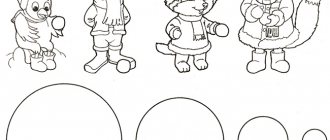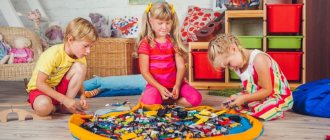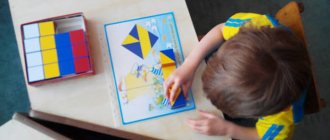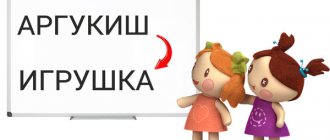All children in the world are united by a love of games.
Play is a natural need for a child, since it is in the form of play that children learn about the world, understand how it works, and consciously comprehend the experience gained.
Play is important not just as a source of joy and good mood, it develops the brain, imagination, creativity, vocabulary, social skills, the ability to learn and perceive more complex information.
How do 6-7 year old children develop?
At this age, the baby’s thinking abilities enter a new, better stage of development.
By age 6, most children:
- master reading, writing, counting to 20;
- understand the simplest time intervals;
- focus longer on one solution to one logical problem;
- their reasoning becomes more meaningful;
- understand information better by listening.
What games are useful at this age?
For a preschooler, different forms of games will be useful.
Psychologists recommend involving children in the following game formats:
- child-initiated play;
- play initiated by an adult;
- a traditional game when both a child and an adult can take the initiative.
From the point of view of benefits, the most significant games are those offered by adults, since in this case the child finds himself in a learning situation, gets acquainted with new words, concepts and can make this situation manageable.
As for choosing a specific game format, it all depends on the situation. For the street, outdoor games are selected that contain an element of sports. At home, you can play board games or role-playing games, or assemble a construction set.
1. Outdoor games develop coordination, strength, endurance, and reaction speed. At the age of 6-7 years, the game lasts about half an hour.
2. Board games help brighten up your leisure time when the weather is bad outside. With the help of cubes, puzzles, figures, cards, the child improves his skills - logic, spatial thinking, social interaction, speech, concentration, will.
There are a huge number of board games - walkers, puzzles, cubes, mosaics, construction sets, flashcards, strategies.
3. Educational games - in this case we are talking about the targeted development of a specific skill or ability, for example, speech, gross motor skills, intelligence, imagination.
The use of such games prepares fertile ground for the further development of the child’s creative abilities and talents. The training program is structured from simple to complex, but the conditions of each task should be slightly ahead of the child’s developmental level.
Game as a method of teaching and education in kindergarten.
Children's play is a means of actively enriching the personality, since it represents a free choice of various socially significant roles and positions, and provides the child with activities that develop his unlimited capabilities and talents in the most appropriate use.A game is a type of unproductive activity, the motive of which lies in the process itself, and the goal is to obtain satisfaction from the player.
The game can be understood in different ways:
— game is a special type of human activity;
- the game is a means of influencing the players (since it is specially organized and has a specific goal);
-game - a special set of rules that require their execution;
-game is a special way of conditionally appropriating the world;
-game- as a form of pedagogical activity.
Any game can implement the entire range of the following functions:
1. emotionally developing function;
2. diagnostic function - hidden talents are revealed;
3. relaxation function - excessive tension is reduced;
4. compensatory function - gives a person what he lacks;
5. communicative function - is an excellent means of communication;
6. function of self-realization - serves as a means to achieve desires and realize opportunities;
7. sociocultural function - during the game a person masters sociocultural norms and rules of behavior;
8. therapeutic function - can serve as a means of treating human mental disorders.
Organizing a high-quality, useful game is a complex and painstaking process. The teacher must master this art (precisely formulate the rules, organize the space, choose the appropriate time, determine the plot of the game, select the game props and competently organize the beginning and ending) When organizing the game, he must choose one or two functions as the main goal that will be him the most important.
The role of play in education in kindergarten
When starting to organize play in kindergarten, educators rely on the already achieved level of development of the children, their inclinations, habits, abilities, and then systematically rebuild the existing interests of the children into the desired ones, increasing the requirements for them, patiently and persistently working on their spiritual growth.
It is important for kindergarten teachers to rely on the role of play in education. But they should not equate play in a child only with entertainment. Let some games be fun entertainment, and others a favorite pastime during leisure hours. It’s good if no one is bored, everyone is busy with something, an interesting game. But not only this determines the inextricable connection between play and the entire process of education. Much depends on the methodology and technique of their organization, on the style of play, and most importantly on its quality. Only in this way can the role of play in education be realized.
The role of play in education is that it is in games that children reveal their positive and negative qualities and the teacher gets full opportunity to properly influence everyone together and each individual.
If the games really captivate the children, then the teacher also has at his disposal the necessary punitive measures, up to and including expelling children from the game for violating the rules or for bad behavior.
Despite the great role of play in education, it cannot be isolated, considered a mono-means, or expected to educate children through games alone.
The role of play in instilling the right attitude towards work is great. Very often it is possible to combine a game so successfully with the labor process that it will decorate the work, cultivate a constant love for it, and help to successfully master the skill.
The educational role of the game is that games teach children to live and work in a team, to take into account the interests of their comrades, to come to their rescue, to follow established rules, and to fulfill the requirements of discipline.
When planning work for the school year, educators set themselves goals and objectives through which they will develop the creative abilities of students, the physical capabilities of children, and help create a friendly children's team, i.e. make the most of the role of play in education. That is why games in all their diversity are widely used in educational work with children.
Most psychologists and teachers consider play in preschool age as an activity that determines the child’s mental development, as a leading activity, during which mental new formations arise.
Play is the most accessible type of activity for children; it is a way of processing impressions and knowledge received from the surrounding world. Already in early childhood, a child has the greatest opportunity in play, and not in any other activity, to be independent, to communicate with peers at his own discretion, to choose toys and use different objects, to overcome certain difficulties logically related to the plot of the game, its rules.
The goal of play therapy is not to change the child or remake him, not to teach him any special behavioral skills, but to give him the opportunity to “live” situations that excite him in the game with the full attention and empathy of an adult.
Using gaming technologies in the educational process, an adult needs to have empathy, goodwill, be able to provide emotional support, create a joyful environment, encourage any invention and fantasy of the child. Only in this case will the game be useful for the development of the child and the creation of a positive atmosphere of cooperation with adults.
At first they are used as separate game moments. Game moments are very important in the pedagogical process, especially during the period of adaptation of children in a child care institution. Starting from two to three years old, their main task is the formation of emotional contact, children’s trust in the teacher, the ability to see in the teacher a kind person, always ready to help (like a mother), an interesting partner in the game. The first play situations should be frontal, so that no child feels deprived of attention. These are games like “Round Dance”, “Catch-Up” and “Blowing Soap Bubbles”.
In the future, an important feature of gaming technologies that educators use in their work is that gaming moments penetrate into all types of children’s activities: work and play, educational activities and play, everyday household activities related to the implementation of the regime and play.
Role-playing game is one of the creative games. In role-playing games, children take on certain functions of adults and, in playful, imaginary conditions specially created by them, reproduce (or model) the activities of adults and the relationships between them. In such a game, all the mental qualities and personality traits of the child are most intensively formed.
Children's independence in role-playing games is one of its characteristic features. Children themselves determine the theme of the game, determine the lines of its development, decide how they will reveal the roles, where the game will unfold. Uniting in a role-playing game, children choose partners of their own free will, set the game rules themselves, monitor implementation, and regulate relationships. But the most important thing in the game is the child embodying his view, his ideas, his attitude towards the event that he is acting out.
The main component of a role-playing game is the plot, which is the child’s reflection of certain actions, events, relationships from the life and activities of others. At the same time, his game actions (cooking dinner, turning the steering wheel of a car, etc.) are one of the main means of realizing the plot.
The plots of the games are varied. They are conventionally divided into:
1. Household (family games, kindergarten)
2. Production, reflecting the professional work of people (hospital, store, hairdresser)
3. Public (Birthday, library, school, flight to the moon)
The content of the role-playing game is embodied by the child through the role he takes on. A role is a means of realizing the plot and the main component of a role-playing game.
Directing play is a type of creative play. It is close to the role-playing game, but differs from it in that the characters in it are not other people (adults or peers, but toys depicting various characters. The child himself gives roles to these toys, as if animating them, he himself speaks for them different voices and he himself acts for them. Dolls, teddy bears, bunnies or soldiers become the protagonists of the child’s game, and he himself acts as a director, managing and directing the actions of his “actors”, which is why such a game is called directorial.
The integrated use of gaming technologies for different purposes helps prepare a child for school. From the point of view of the formation of motivational and emotional-volitional readiness for school, each play situation of communication between a preschooler and adults, with other children is for the child a “school of cooperation”, in which he learns to both rejoice in the success of a peer and calmly endure his own failures; regulate their behavior in accordance with social requirements, and equally successfully organize subgroup and group forms of cooperation. The problems of developing intellectual readiness for school are solved by games aimed at developing mental processes, as well as special games that develop elementary mathematical concepts in a child, introduce him to the sound analysis of words, and prepare his hand for mastering writing.
Thus, gaming technologies are closely related to all aspects of the educational work of a kindergarten and the solution of its main tasks. However, there is an aspect of their use that is aimed at improving the quality of the pedagogical process by solving situational problems that arise during its implementation. Thanks to this, gaming technologies turn out to be one of the mechanisms for regulating the quality of education in kindergarten: they can be used to level out negative factors that influence the decrease in its effectiveness. If children are systematically engaged in play therapy, they acquire the ability to manage their behavior, tolerate prohibitions more easily, become more flexible in communication and less shy, cooperate more easily, express anger more “decently,” and get rid of fear. Their play activities begin to be dominated by role-playing games depicting people’s relationships. Folk games with dolls, nursery rhymes, round dances, and joke games are used as one of the effective types of game therapy. Using folk games in the pedagogical process, educators not only implement the educational and developmental functions of gaming technologies, but also various educational functions: they simultaneously introduce students to folk culture. This is an important area of the regional component of the kindergarten educational program, which is still insufficiently developed.
In theatrical games (dramatization games), the actors are the children themselves, who take on the roles of literary or fairy-tale characters. Children do not invent the script and plot of such a game themselves, but borrow it from fairy tales, stories, films or plays. The task of such a game is to, without deviating from the well-known plot, reproduce the role of the character assumed as accurately as possible. The heroes of literary works become characters, and their adventures, life events, and changes by children’s imagination become the plot of the game.
The peculiarity of theatrical games is that they have a ready-made plot, which means the child’s activity is largely predetermined by the text of the work. Theatrical play is a rich field for children's creativity. Creative role-playing in a theatrical play is significantly different from creativity in a role-playing game. In role-playing games, the child is free to convey the image of role-playing behavior. In a theatrical play, the image of the hero, his main features, actions, and experiences are determined by the content of the work. The child's creativity is manifested in the truthful portrayal of the character. To implement it, the child must understand what the character is like, why he acts this way, and imagine his state and feelings. To play the role, the child must master a variety of visual means (facial expressions, body movements, gestures, expressive and intonation speech). Theatrical and play activities enrich children in general with new impressions, knowledge, skills, develop interest in literature and theater, form dialogical, emotionally rich speech, activate the vocabulary, and contribute to the moral and aesthetic education of each child.
Thus, the phenomenon of play should be treated as a unique phenomenon of childhood. Play is not only an imitation of life, it is a very serious activity that allows a child to assert himself and realize himself. By participating in various games, the child chooses characters that are closest to him and correspond to his moral values and social attitudes. The game becomes a factor in the social development of the individual
Conclusion
So, play occupies an important place in the organization of children’s lives. Games are repeated daily, and on “their shoulders”, in favorable conditions, the children’s team grows and strengthens, with its inherent diversity of interests, the joy of communication, and social life skills. The games clearly show the level of social education, moral qualities, social behavior skills of children, and the level of their interests.
The process of play in preschoolers requires the involvement of the teacher, but with different goals, at different levels of development of relations between children. When a teacher enters the center of a child’s life - the circle of relationships that develop between children, then it is easy for him to navigate the organization of the game. From this follows the conclusion that it is necessary to master the skill of managing the game to such an extent that you are ready at any moment to show the children the game, play it with them, evaluate their achievements in mastering the rules and the still small but still existing technique of the game. For a child, mastering a new game means gaining new experiences. When the children master the game, then we will say: “Now you already know how to play yourself.” The more contact he has with children, the more often an adult acts as a connoisseur and advisor. The assessment should be made in a friendly manner, avoiding the tone of instruction or order.
We take the game as the life of children with all the contradictions, feelings, experiences, actions it contains, in general, with manifestations of an integral human personality. If for a child play is true life, then by organizing this life well and wisely we get great opportunities in raising children.
LIST OF REFERENCES USED
1. Azarov YL. Play and work. - M., 1973. Azarov YL. The art of education. - M., 1979.
2. Anikeeva N.P. Education by playing. - M., 1987.
3. Gazman O.S. etc. To school - with a game. - M., 1991.
4. Guruzhapov VA. Questions of examination of educational technologies // Psychological science and education. 1997. No. 2.
5. Zanko S.F. et al. Game and learning. - M., 1992.
6. Zimnyaya A. N. Pedagogical psychology - M., 2000.
7. Games - education, training, leisure... / Ed. V.V. Letrusinsky. - M., 1994.
8. Ilyina TA. Pedagogy. - M., 1984.
9. Clarin M.V. Pedagogical technology. - M., 1989.
10. Likhachev B.T. Pedagogy. - M., 1992.
11. Minkin E. M. From game to knowledge. - M., 1983.
12. Nikitin B.P. Steps of creativity, or educational games. - M, 1990.
13. Pedagogy / Ed. Yu.K. Babansky. - M., 1983.
14. Pedagogical creativity at school (from the experience of Russian teachers) / Ed. V.F. Krivosheeva - M., publishing house of the Scientific Research Institute of Schools of the RSFSR Ministry of Defense, 1992. - 114 p.
15. Samukina N.V. Organizational and educational games in education. - M.: Public Education, 1996.
16. Stolyarenko V.A. Educational psychology - Mn. ,2000.
17. Yakovlev N.M., Sokhor A.M. Lesson methods and techniques at school. - M., 1985. - 163 p.
18. Yanovskaya. M.G. Creative play in educating primary schoolchildren. - M., 1974.
Games 30. Plant
First of all, you need to make a plant - a tree, a flower - from any available materials. Then the child composes a fairy tale about him. The main thing is that in the story the child describes in detail how the plant feels - is it comfortable or is something bothering it.
Through these metaphors, an adult can understand what is bothering the child. If there is a cause for concern, ask your child what you can do to help the plant - build a fence, call a fairy, plant other trees. This way the baby will use the example of a fairy tale to cope with his anxieties.
Games 31. Face games
In children who have suffered some unpleasant events in life, a frozen mask may appear on their face and emotions disappear. You can motivate your child in several ways - invite him to play tricks, make funny faces with him, or organize a home theater.
Games 32. Simple holidays
Allow your baby to feel the holiday in your life as often as possible. Try to turn every simple event into something bright and unusual. For example, the festival of making the bed, washing, the festival of lunch. Be sure to record any of your child’s achievements, write them down or draw them - this motivates and builds confidence in yourself and your abilities.
Games 33. Color therapy
If your child often returns to unpleasant events in the past, focus his attention on the current day, for example, come up with a specific color for each day of the week and try to stick to it. For example, let Monday be blue - pick up such clothes, look for blue objects around.
Games 34. Schedule
To stabilize a child’s condition after a stressful situation, it is necessary to structure his daily routine, draw up a schedule, and decorate it. The kid must monitor its implementation. On the one hand, it teaches discipline, and on the other, it distracts from unpleasant thoughts.
Advice! Anxious children prone to stress intuitively choose outdoor games where they need to jump. This helps relieve tension and feel supported. Create an area for your child where he can jump safely and happily.
Conflict situations sometimes occur between children, and here play becomes critically important, since with its help the child relieves stress and relaxes . Of course, games should be appropriate for the child’s age and development, be diverse and useful. This is what we will talk about in our material.
Where to find time to play with your child
This question is asked by many parents, since modern moms and dads are busy people who have a lot of household responsibilities, work, of course, and a natural desire to take time for themselves and relax. Due to the fact that there is not enough time to spend with the baby, parents often worry and worry. Psychologists assure that you can find time to communicate with your child if you follow simple tips.
Tip 1 – play with your child and mind your own business at the same time.
Games that do not require special training or additional items can be played in the kitchen, bathroom, or on the street. If you don’t feel like playing, involve your child in homework, do something together, for example, make pizza, or just let your child help you.
The main thing is to talk to the child more, explain, praise and support.
Tip 2 – use any free minute.
Transport, queues, the road to somewhere - this time can be used profitably. Tell your child about natural phenomena, make riddles, compose fairy tales, play counting and words.
Tip 3 – games and activities should become a habit.
Of course, we are not talking about classes for an hour or two. Make it a rule to work with your child every day for 15-20 minutes; this will be quite enough for a child aged 6-7 years. For example, read a book to your child before bed.
Tip 4 – try to create a nurturing environment at home.
Use posters, manuals, cards, magnetic games. The more educational objects there are around a child, the faster he will remember information. Please note that developmental aids should be bright and colorful.
Tip 5 – find company for your child.
If this is the case and you cannot play with your baby, try to find children for him with whom he can spend his time.
Educational games in preschool education
Tatiana Morozova
Educational games in preschool education
The term " educational games "
was first used by a wonderful teacher, the father
of educational games, Boris Pavlovich Nikitin.
What are educational games ? The answer is in the title itself. Educational games are those games that contribute to the development of a child . It doesn’t matter whether we are talking about the development of fine motor skills , speech, creativity, etc. A game that contributes to the development of any intellectual or physical skill is developmental .
Thus , the essence of the educational game need to complete some task, and in order to complete it, you need to think. Such games and toys develop children's speech , thinking, logic, fine motor skills, perseverance, and creativity.
Distinctive feature of educational games :
In educational games - this is their main feature - they combine one of the basic principles of learning from simple to complex with the very important principle of creative activity independently according to ability, when a child can rise to the “ceiling”
your capabilities.
This union allowed the game to solve several problems related to the development of creative abilities:
firstly, educational games can provide “food”
to
develop creative abilities from a very early age;
secondly, their stepping stone tasks always create conditions that precede the development of abilities ;
thirdly, rising each time independently to your “ceiling”
, the child
develops most successfully ;
fourthly, educational games can be very diverse in their content and, moreover, like any games , they do not tolerate coercion and create an atmosphere of free and joyful creativity;
fifthly, by playing these games with their children , fathers and mothers quietly acquire a very important skill - to restrain themselves, not to interfere with the child’s thinking and making decisions, not to do for him what he can and should do himself.
The five points listed above correspond to the five basic conditions for the development of creative abilities. It is thanks to this that educational games create a unique microclimate for the development of the creative sides of the intellect.
Types of educational games .
Games for planar and volumetric modeling.
Such games include: “Fold the square”
,
“Tangram”
,
“Columbus Egg”
,
puzzle games . These games not only develop imaginative thinking , but also the ability to create an imaginary image , choosing the right solution path for this, orienting oneself in space, and showing perseverance and ingenuity.
Transformation games (transfiguration, transformation )
.
These include geometric puzzles (from matches, counting sticks)
for constructing, changing figures,
transforming one into another while maintaining the number of matches. Toys - transformers, square by V.V. Voskobovich. Such games develop variable thinking, spatial concepts, and the ability to carry out appropriate actions .
Games for combinatorics , movement, replacing places.
"Four by Four"
,
“Parquets”
,
“Colored panel” (author S. V. Kovalev)
.
These games are exciting , effective, promote the choice of a rational solution, and develop the ability of the player to make the right decision.
Logic games with intersection , building algorithms, changing the properties of figures according to certain rules.
In these games, as a rule, the didactic manual “Dienesh's logical blocks”
or sets of logical geometric shapes.
Games are easy to construct provided the basic logical rules and sequence of actions are followed.
The most effective aid is the logical blocks developed by the Hungarian psychologist and mathematician Dienes to prepare children's thinking for mastering mathematics.
Artistic and educational games : select a palette for a painting, select a diagram for a painting).
At what age should you start playing educational games ? Nobody asks when to start teaching a child to speak. From birth, parents talk to their baby, thereby preparing the ground for the development of the child’s speech . Same with educational games , such a question should not arise. There are many games that need to be played with children from birth, developing their hearing , vision, fine motor skills: these are rattles, mobiles, finger games , songs.
Methodology for organizing and conducting educational games
1. The new game is not explained to the child; he is drawn into it with the help of a fairy tale and imitates an adult.
2. Mastering a new game , as a rule, requires the active participation of elders; In the future, the child can study independently.
3. The child is given a number of tasks that become more complicated in the future.
4. The child cannot be given any hints. He must be able to think for himself.
5. If the child cannot cope with the task, you need to return to easy, already completed tasks, or temporarily stop the game.
6. If a child has reached the ceiling of his capabilities or has lost interest in the game, he needs to put it off for a while. This technique allows the child to independently search for solutions to problems unknown to him, to create new things, that is, it leads to the development of his creative abilities.
Let's look at how to start playing the tangram game.
Where to begin?
The very first exercise with such a game is to create a figure from two or three elements. For example, make a square or a trapezoid from triangles. The child must navigate the puzzle: count all the triangles, compare them by size.
• Then you can simply put the parts next to each other and see what happens: a mushroom, a house, a Christmas tree, a bow, a candy...
During the game, you can tell that the puzzle is called “Tangram” in honor of the scientist who invented it.
Second phase
• After several lessons and games with a tangram, you can move on to exercises on folding figures according to a given example. In these tasks you need to use all 7 puzzle elements.
Start by making a hare, this is the simplest of the figures below.
A ball of fluff -
Long ear.
Jumps deftly
Loves carrots (hare)
.
Third stage
• More difficult and interesting for the children is recreating figures using contour samples . This is the third stage of mastering the game . Recreating figures along contours requires visual division of the form into its component parts, that is, into geometric shapes. It is recommended to offer such tasks in kindergartens to children from 6-7 years old (I think it’s too late)
.
One of the first tasks at this stage is the running goose, it’s better to start with it. First, analyze with your child what parts the head, neck, and paws of a goose may consist of. Is it possible to make them from other parts...
You can spend more time applying different elements of the puzzle, looking for the correct result.
This is more complicated - figures of a person running and sitting, geometric figures.
Intelligence of a child aged 6-7 years
At this age, children have already formed personalities and have their own views on the world around them and what is happening in it. The child understands his position both in the children's team and among adults, and accordingly builds a line of behavior and forms a certain attitude towards the people who surround him.
The level of emotional development in children 6-7 years old is also quite high. They show sympathy , empathize, feel the mood of other people, and offer help.
- We are talking about children who are almost first graders, they can control their mood, follow the instructions and requests of adults, and take part in group and individual activities.
Advice! Since children 6-7 years old easily navigate circumstances, parents can give their child the basics of personal safety and teach them to find a way out of difficult situations.
2. At 6-7 years old, children show an active interest in new knowledge, since at this age the memory capacity increases, the child’s attention becomes more concentrated, and the vocabulary expands (up to 6 thousand words).
3. Parents need to continue classes on the development of children’s speech, familiarize children with the structure of language, in addition, develop fine motor skills, logic, and the ability to systematize objects by characteristics.







